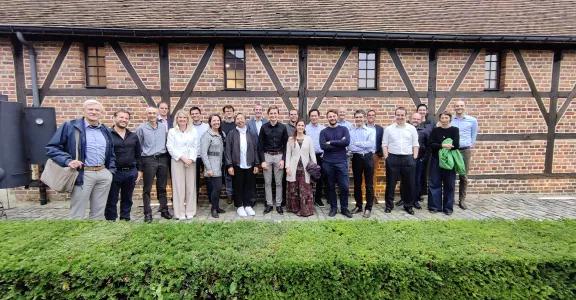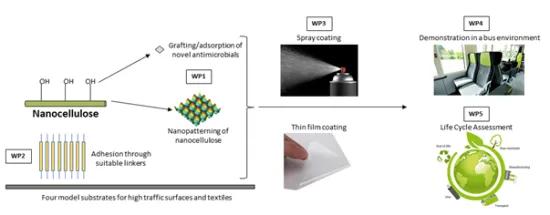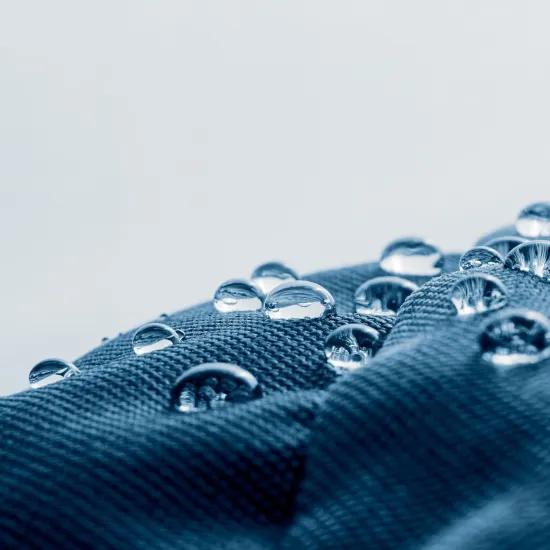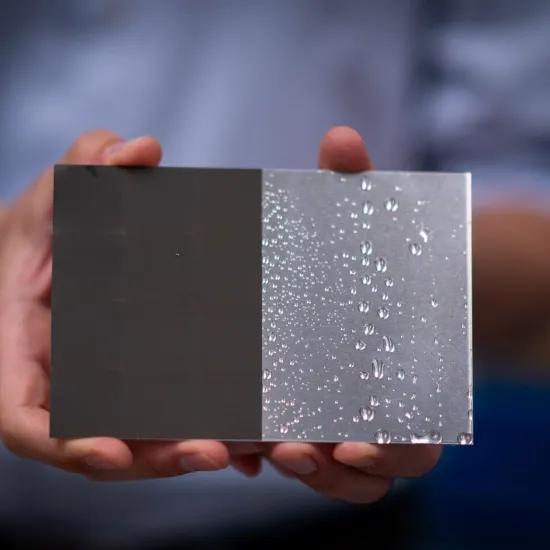Last September, the European Triple-A-COAT project was kicked-off by the project partners having a 2-day meeting in Leuven. The project aims to develop a bio-based nanocellulose coating platform with different antiviral/antimicrobial mechanisms for surfaces and textiles in high traffic areas. The resulting coating will be applicable by spray coating or as a thin film.
Human pathogens can persist on textiles and high-traffic surfaces for hours, days or even longer when protected by biofilms, increasing the risk of infection spreading. Conventional cleaning has no lasting effect as contamination can re-occur almost immediately. Available antimicrobial coatings are based mainly on the release of silver ions and other biocides that present risks for resistance development and environmental damage. Inorganic nanoparticles are also a concern for human health.
Therefore, a more efficient alternative is needed and that is what the project partners of the new European Triple-A-COAT project want to develop.
Nanocellulose
Nanocellulose, which will be used in the project as the base material, is a versatile nanomaterial obtained from wood pulp or biotechnological methods. It has excellent physical properties for coatings, enabling controllable and standardised application of antimicrobial functionalities.
In Triple-A-COAT three forms of nanocellulose will be augmented for antimicrobial/antiviral activity through grafting/adsorption of novel, resistance-proof compounds with excellent activities against bacteria, fungi and/or viruses, and nanopatterning to create bio-inspired antimicrobial surfaces.
The goal of the project is to meet or exceed current antimicrobial/antiviral/antifungal coatings efficacy, but with a minimal risk of resistance development and avoiding the safety issues of inorganic nanoparticles.
Within 5-10 years after the end of the project, the results will be commercialized for impact in the transportation and healthcare sectors, contributing to the better control of infectious disease, and boosting the competitiveness and research leadership of EU industry including SMEs.
Project approach
Antimicrobial and/or antiviral activities are based on the following nature-inspired approaches:
- Functionalization of nanocellulose with novel nature-inspired antibiofilm compounds and antimicrobial/antiviral peptides, either by adsorption, or by covalent grafting to the considerable number of protruding hydroxyl groups.
- Nature-inspired nanopatterning of nanocellulose to prevent microbial adhesion and growth.
All of the main types of nanocellulose, cellulose nanocrystals (CNC) and cellulose nanofibers (CNF) produced mainly from wood pulp, and bacterial nanocellulose (BNC) produced by biotechnological fermentation, will be explored in the project. Each will contribute specific advantages based on distinctive physical properties, and they may be used individually, or in combination. Doing so, the Triple-A-COAT project will provide a toolbox of antimicrobial/antiviral activities, formulations and application methods, adaptable to differing applications, pathogen threats and user requirements. The coatings will be developed as spray coatings or thin films, for application during manufacture or to existing surfaces as required.
All coatings will meet user requirements for durability and be non-toxic after application. The project will proceed from TRL3 and reach TRL6, including a demonstration of the coatings in a bus as a relevant environment, featuring both high traffic surfaces and textiles. c
Join us!
As a part of the open science strategy, the Triple-A-Coat project welcomes companies from the whole value chain, public service providers, other potential lead users and final end users from across Europe to participate in the project user committee. This will allow the consortium to interact closely with professionals involved in management of infection risk, facilities management and other relevant areas of expertise.
Why join this project? The user committee members can get first insights into the developments within the project and will be primary candidates for participation in demonstration or dissemination activities. User committee members will be invited to regular progress (teleconference) meetings and receive a newsletter.
Interested to be part of this user committee? You can apply by sending an e-mail to Patrick.cosemans@sirris.be with a short introduction of your company and a motivation to be part of this user committee. Based on this the consortium will evaluate your candidacy in order to obtain a well-balanced committee representing the value chain and the European countries involved.







